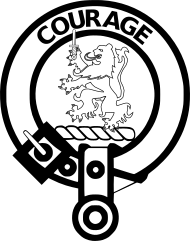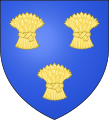Clan Cumming
| ||||||||||||||||||||
| ||||||||||||||||||||
| ||||||||||||||||||||
| ||||||||||||||||||||
| ||||||||||||||||||||
| ||||||||||||||||||||
Cumming (auch Comyn) ist der Name eines schottischen Clans.
Geschichte
Richard Comyn († 1178), Neffe des William Comyn († um 1160),[1] der Kanzler unter König David I., etablierte die Familie in Schottland. Er heiratete Hextilda, Enkelin König Donalds III. Sein Sohn William Comyn wurde durch zweite Ehe Earl of Buchan. Dessen stammältester Urenkel, John „the Black“ Comyn († um 1302), Lord of Badenoch, und dessen Sohn John „the Red“ Comyn († 1306), Lord of Badenoch, waren als Nachfahren Donalds III. Anwärter auf den schottischen Thron und traten dadurch im Laufe des Ersten Schottischen Unabhängigkeitskriegs in Rivalität zu König Robert Bruce, der Letzteren 1306 in der Kirche von Dumfries ermordete. Der ganze Clan Comyn erhob sich daraufhin gegen Robert Bruce, wurde geschlagen und die wesentlichen Ländereien entzogen.
Nach dem Aussterben der Hauptlinie der Comyn of Badenoch im 14. Jahrhundert, ging die Würde des Clan Chief an den Familienzweig der Lords of Altyre in Moray über, dessen Oberhaupt diese Würde bis heute innehat. Ab dem 15. Jahrhundert hatte der Clan in den Highlands wieder einigen Einfluss gefestigt und tat sich im 15. und 16. Jahrhundert durch blutige Fehden gegen rivalisierende Clans hervor.
Herkunft des Namens
Die Herkunft des Namens ist nicht eindeutig. Einige leiten es von der englischen Bezeichnung für Kümmel (Cumin) ab, andere von einem Abt des 7. Jahrhunderts mit Namen Comineus. Der Name könnte auch ein Herkunftsname abgeleitet von Bosc-Bénard-Commin bei Rouen in der Normandie[1] oder von Comines in Flandern sein.[2][3][4] Es wird bezweifelt, dass die Wurzeln des Clans in der Normandie liegen, da der Name bereits vor dem Jahre 1096 erwähnt wurde: Ein Ritter Robertus Cummine fiel 1093 in der Schlacht von Alnwick.
Bilder
- Stammwappen des Clan Cumming
- Tartan
Einzelnachweise
- ↑ a b Alan Young: Cumin [Comyn], William (d. c. 1160). In: Henry Colin Gray Matthew, Brian Harrison (Hrsg.): Oxford Dictionary of National Biography, from the earliest times to the year 2000 (ODNB). Band 14: Cranfield–Dalwood. Oxford University Press, Oxford 2004, ISBN 0-19-861364-4 (doi:10.1093/ref:odnb/49374 Lizenz erforderlich), Stand: 23. September 2004.
- ↑ Charles MacKinnon: Scottish Highlanders. Barnes & Noble Books, New York 1984. S. 139.
- ↑ Neil Grant: Scottish Clans and Tartans. The Lyons Press, Guilford (Connecticut) 2002, S. 58.
- ↑ James Balfour Paul: Comyn, Lord of Badenoch. In: James Balfour Paul (Hrsg.): The Scots Peerage. Band 1: Abercorn–Balmerino. David Douglas, Edinburgh 1904, S. 503–510 (englisch, Textarchiv – Internet Archive).
Literatur
- Ian Grimble: Scottish Clans and Tartans. Book Sales, New York 2002, ISBN 0-785-81508-2.
- Lachlan Shaw: The history of the Province of Moray. Comprising the counties of Elgin and Nairn, the greater part of the County of Inverness and a portion of the County of Banff, all called the Province of Moray before there was a division into counties. Neuausgabe in 3 Bänden, London/Glasgow 1882. (Band 1, Internet Archive, Band 2, Internet Archive, Band 3, Internet Archive).
- The Scottish Tartans. Stirling 1984.
Weblinks
- Comyn, Cumming bei electricscotland.com (englisch)
- Website der Clan Cumming Society of the USA (englisch)
Auf dieser Seite verwendete Medien
Autor/Urheber: Czar Brodie~commonswiki, Lizenz: CC BY-SA 4.0
Quarterly, 1st & 4th, three garbs Or (Cumming); 2nd & 3rd, Argent, three bends Sable, each charged with as many roses of the field [thorns or] (Penrose); overall, in an escutcheon Argent, is placed the Arms, Crest, Motto and Supporters of Gordon of Gordonstoun
Autor/Urheber: Celtus (Celtus @ english wikipedia), Lizenz: CC BY-SA 3.0
The copyright for this representation of the Scottish crest badge is held by the author of this image. In Scotland, the usage of heraldry is governed by legal restrictions, independent of the status of the depiction shown here. The crest and motto elements of the crest badge are always the heraldic property of an individual (the crest badges, used by most Scottish clan members, are usually the heraldic property of a clan's chief). Though a crest badge can be freely represented, in Scotland it cannot be appropriated or used in such a way as to create a confusion with or a prejudice to its owner.
Autor/Urheber: Celtus, Lizenz: CC BY-SA 2.5
Comyn tartan, as published in the Vestiarium Scoticum.
Vestiarium Scoticum page.91, plate.44 "Cymyne hath twa wyd stryppis of greine vpon ane scarlatt fyeld, and withovt thir sayd strippis twa lesser of ye samen, and throuch ye twa greitter stryppys ane spraing quhite, and vpon ye myddest of ye redd sett ane sprang blak."
Modern thread count: Bk4 R54 G8 R4 G8 R8 G18 W2 G18 R8.
Autor/Urheber: Newm30, Lizenz: CC BY-SA 4.0
Arms of John Comyn, Lord of Buchan (d.1308): Azure, three garbs or.







